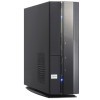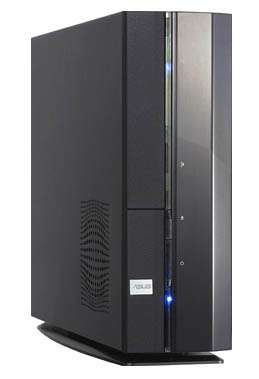- Qualcomm Launches Snapdragon 4 Gen 2 Mobile Platform
- AMD Launches Ryzen PRO 7000 Series Mobile & Desktop Platform
- Intel Launches Sleek Single-Slot Arc Pro A60 Workstation Graphics Card
- NVIDIA Announces Latest Ada Lovelace Additions: GeForce RTX 4060 Ti & RTX 4060
- Maxon Redshift With AMD Radeon GPU Rendering Support Now Available
ASUS P-Series AMD 690G Barebone PC

What if you could build a sub-$500 HTPC that was slim, fast, and capable, without the headache of picking bargain-barrel parts to accomplish your design goals? What if it had HDMI and 7.1 audio? With the help of their Pundit series, ASUS hopes to make barebones relevant again. Have they done it?
Page 1 – Introduction
Remember barebone systems? Those cheap-looking cases standing open at the local Steve’s Computer Emporium, ugly low-end motherboards bared, promising a quick, inexpensive system with the addition of only a CPU, memory, storage, and expansion cards? Somehow, whoever designed those systems always knew how to pick the un-sexiest cases imaginable, and pair them with the chintziest power supplies and the sketchiest motherboards, all in an effort to woo your dollar with the promise of a system with the specs you wanted, but at a lower final price.
You may have seen those barebone systems of old and wondered to yourself, “who in their right mind would spring for one of these el-cheapo monstrosities?” And yet somehow they still sold, and the approach caught on, since it seemed like every major PC hardware supply house had their own selection.
More recently, the barebone system format has proven useful to manufacturers like Shuttle with their popular small-form-factor gaming PCs. With the barebone format, there’s no need to create a new motherboard standard when a different form factor is desired, and try to coerce case manufacturers into picking the standard up – the case, motherboard, and power supply match by design.
Alternate form factors are an arena where the barebone-style product really shines, whether it’s Shuttle with their cube-shaped xPC models, or with small-form-factor “slim desktop” and “book-style” PCs that try to cram full PC functionality into an impossibly small space. Of course, there are Micro-ATX barebone systems out the ‘wazoo’ as well, since that’s where barebone systems first became popular, thanks to a smaller selection of Micro ATX motherboards than exists today.

The ASUS Pundit series of barebone PCs is built around a ‘book-style’ chassis that’s intended to save desk space. In this article, we’ll be taking a look at an ASUS Pundit P2-M2A690G barebone system, which is especially interesting because of the AMD 690G IGP’s ability to support HDMI output. That gives the P2-M2A690G a particular noteworthy point over many of its plain-Jane competitors – with just the onboard video solution, it would appear that the Pundit P2-M2A690G barebone provides the necessary underpinnings for a capable home theater PC.
Aside from its HDMI output feature, the P2 690G barebone system is relatively standard fare. It relies on an integrated graphics chipset (the AMD Radeon X1250), and its built-in motherboard is simply a different layout of the company’s M2A-VM Micro ATX motherboard that’s also based on the AMD 690G chipset. Does the combination of a socket AM2 platform with integrated ATI graphics deliver the functionality and versatility that barebone system buyers are looking for?
Support our efforts! With ad revenue at an all-time low for written websites, we're relying more than ever on reader support to help us continue putting so much effort into this type of content. You can support us by becoming a Patron, or by using our Amazon shopping affiliate links listed through our articles. Thanks for your support!




